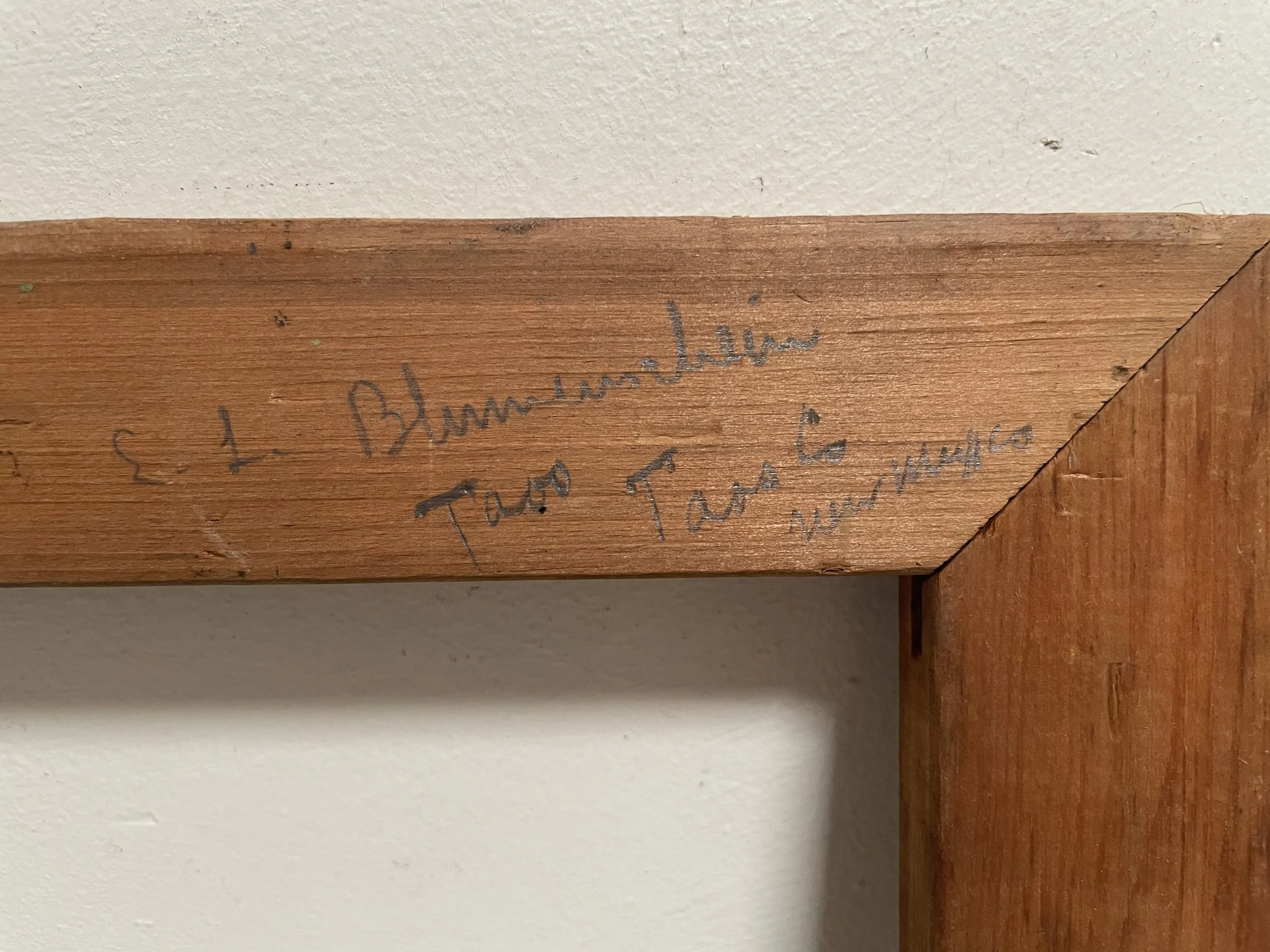Ernest Leonard Blumenschein
To be contacted when more E.L. Blumenschein works become available E-mail us HERE
Do you have an E.L. Blumenschein you would like to sell? Contact us HERE
We are actively buying and selling EL Blumenschein Paintings. Contact us for details. We can wire money within 24 hours!
Maxwell Alexander Gallery is proud to present a new arrival by Taos Society of Artists Founding Member, Ernest Leonard Blumenschein.
The oil painting from 1928 includes the original gallery label on verso, along with the artist's signature on the front (lower left) and back (upper stretcher bar): "E L BLUMENSCHEIN"
Upon further inspection of backing, alternate titles were found written in the artist's hand, along with "Taos. NM." This painting was owned by the same family since its original purchase, until recently.
The alternate title of "Halfbreed and His Family" indicates the mixed race of the main figure, presumably Half Mexican and Half Native American. This painting includes Blumenschein's signature brushstrokes, with thick paint throughout, especially in the main figure's blanket. The blanket covered background figures are painted in a modern simplified manner, something Blumenschein became most known for. Lastly, "Mexican in Hallway / Halfbreed and his Family" comes in its original frame.
Ernest Leonard Blumenschein (May 26, 1874 – June 6, 1960) was an American artist and founding member of the Taos Society of Artists. He is noted for paintings of Native Americans, New Mexico and the American Southwest.
This new arrival is available now and being sold on a first come first served basis.
MEXICAN IN HALLWAY / HALFBREED AND HIS FAMILY
14" x 20" Oil Circa 1927
AVAILABLE NOW! For pricing and other questions: info@maxwellalexandergallery.com
E.L. Blumenschein Biography
A founder of the Taos Art Colony in Taos, New Mexico, Ernest Blumenschein became one of the Southwest's best-known painters of pueblo Indian genre. However, this period in his career for which he was most known came relatively late in his life as he had strong academic training in New York and Paris followed by a flourishing career as an illustrator in the East.
He was born in Pittsburgh, Pennsylvania, the son of a prominent musician and had early exposure to both music and art. In Cincinnati, he attended the College of Music and The Art Academy, and then went to New York to the Art Students League. In New York, he supported himself as a violinist for the symphony and in 1894, played first violinist under conductor Antonin Dvorak.
In 1895, he studied in Paris at the Julian Academy where he became a close friend of Joseph Henry Sharp and Bert Phillips. Sharp told them about the marvelous landscape in New Mexico and encouraged them to join him there.
In New York, Blumenschein shared a studio with Phillips, and in 1898 with Blumenschein on assignment from McClure's magazine to sketch the Southwest, he and Sharp traveled to Arizona and New Mexico. They inadvertently stopped in Taos when their wagon wheel broke because it was the nearest town. This adventure, which led to both of them ultimately settling there, was the beginning of the Taos Art Colony, a group composed of eastern artists who depicted the landscape and pueblo Indians.
Until 1919, he divided his time between Taos and New York City where he taught at the Art Students League and he and his wife, Mary Shepard Greene, worked together on illustration assignments. In 1919, having spent their summers in Taos, the couple moved there permanently. They moved at first into a small structure on Ledoux Street, but acquired more property on both sides and eventually lived in an eleven-room house. Mary became a noted designer of jewelry, inspired by designs she saw in the natural landscape.
In the Southwest, his painting became brighter, and his earlier illustration style changed to one that was more mystical and intuitive of Indian subjects. His later work had especially dense pigment because he had trouble finishing work and painted it over and over. He continued to paint in Arizona as well as New Mexico, completing a work in 1929 called Apache Country, and from 1932 to 1957, working on a painting he titled Arizona Dam, showing the modernization of that state with a dam along the Colorado River. The location is likely Roosevelt Dam, but the painting is abstract enough that it is difficult to tell the exact location.
Among his Taos colleagues Blumenschein was the best known nationally at that time, and traveling widely, stayed in touch with art movements throughout the country. His painting style tended to be much more modernist than many of New Mexico peers, and he was considered quite intellectual because of his articulations and interest in stimulating discussions of art theories.
Sources include:
Peggy and Harold Samuels, The Illustrated Biographical Dictionary of Artists of the American West
James Ballinger, Visitors to Arizona 1846 to 1980
Walt Reed, The Illustrator in America, 1860-2000





